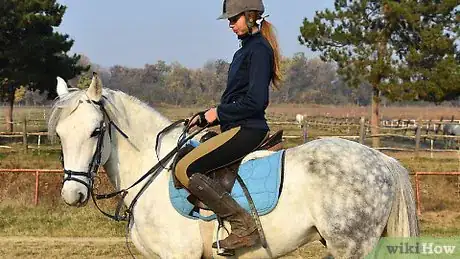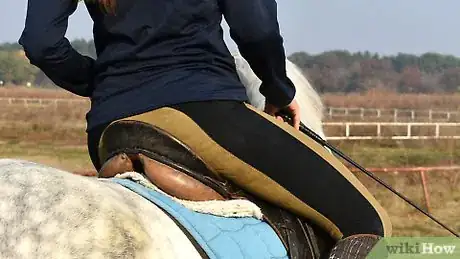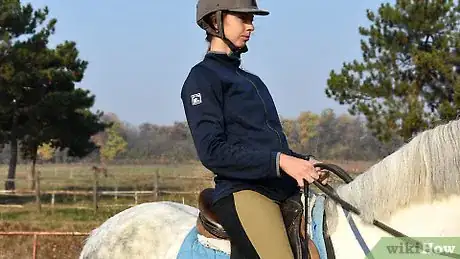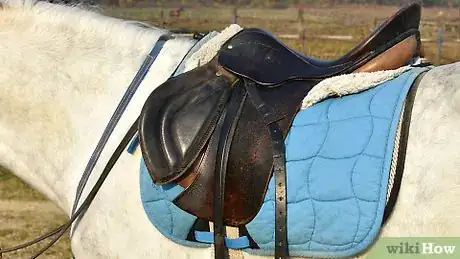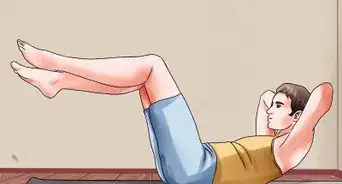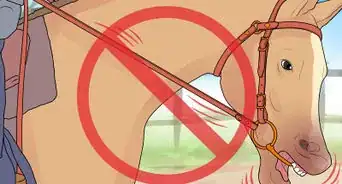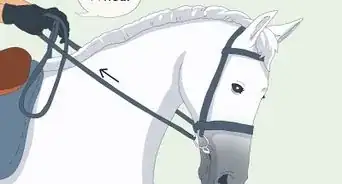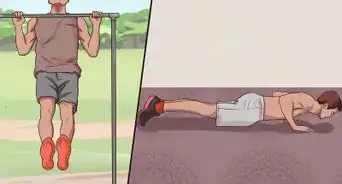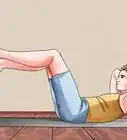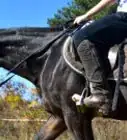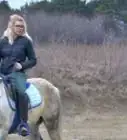This article was co-authored by Pippa Elliott, MRCVS. Dr. Elliott, BVMS, MRCVS is a veterinarian with over 30 years of experience in veterinary surgery and companion animal practice. She graduated from the University of Glasgow in 1987 with a degree in veterinary medicine and surgery. She has worked at the same animal clinic in her hometown for over 20 years.
This article has been viewed 158,225 times.
Many people learn to steer horses using the reins. This is generally effective, but there may be times when knowing how to steer using only your legs may come in handy. By positioning your legs in place and applying pressure to the right spots, you can communicate to your horse that you want to turn left or right.[1] You can also command your horse to speed up or slow down by simply adjusting your hips and pelvis within the saddle.
Steps
Steering With Your Legs
-
1Angle your legs under your hips. If you want to steer with your legs, you'll need to get your legs angled so that you can give your horse this command. Don't maintain a tight grip with your legs around the horse's ribs, as this will lift you out of the saddle and forfeit some of your deep-seat control.
- Keep your legs directly under your hips. Your body should be aligned from your ear all the way to your heel.
- Angle your feet so that your heel is lower than your toe. Turn your toes slightly out so that your lower leg has more contact with the horse's body.
- Let your legs gently touch the horse's body from the thigh down to the ankle.
-
2Turn your head towards the direction you want to move in. Turning your head will help you have a better command of where you want to go. Keep your chin up and look straight at a fixed point (a tree, a fence post, etc.) in the direction you want to turn. Let your shoulders turn just slightly. If you turn your shoulders too much you risk losing your balance.[2]Advertisement
-
3Rotate your hips in the desired direction. Once you've fixed your eyes on a spot you want to turn towards, begin rotating your hips towards that spot. This will send a message to your horse, indicating that a change of course is approaching.[3]
- Try to maintain a stable position with the rest of your body. Just give a slight twist of the hips.
- Don't rotate too abruptly, or again, you run the risk of losing your balance.
-
4Squeeze with your legs to execute the turn. Once your shoulders and hips are facing the desired direction, you'll use your legs to steer the horse's body. You'll need to coordinate both legs and control how much pressure you use from each leg, as this will affect the turn greatly.[4]
- Squeeze gently just behind the horse's girth with the leg outside of the turn you're trying to complete. For example, if you're turning left, your right leg would be your outside leg.
- Use your inside leg to apply a gentle pressure directly on the horse's girth.
- If you're turning left, your left leg should press against the horse's left girth and your right leg should squeeze just behind the horse's right girth.
- If you've done everything correctly, your horse should have turned in your desired direction. if the horse didn't turn, keep practicing or consider trying a more cooperative horse.
Controlling Your Horse's Speed
-
1Move your hips with your horse's movement. As you ride around a fenced-in area on your horse and post with its movements, you should begin to get a sense of your horse's rhythm and the timing of its feet. Once you learn your horse's movements, you can gently move your hips with the horse's rhythm to maintain better control through the seat.
- Post the trot by rising out of the saddle slightly for one beat and lowering back into your seat for the second beat. Don't bounce up and down, just move gently with your horse's movements.
-
2Keep your pelvis tilted slightly forward. As your horse moves, your pelvis rocks forward and backward in synch with the horse's movements. Your pelvis will naturally match your horse's gait, but you can alter your horse's speed by keeping your pelvis in position and adjusting your pelvic movements.
- Angle your pelvis slightly forward. Try to maintain your center of balance, and don't lean too far forward or you may get disoriented.
-
3Speed up your horse's movement. With your pelvis and hips in place, you should be able to spur your horse to go faster using only your body's posting movements. This may take some practice, so be patient and stick with it.
- Increase contact between your legs and the horse's sides. A very gentle squeeze will let the horse know you wish to go forward, and your hips/pelvis will adjust the horse's speed.
- Some horse riders deliver a gentle kick in the sides if a horse doesn't get the hint that you want it to speed up.[5]
- Move your hips and pelvis forward and backward at a faster speed than the horse is rocking you.
-
4Slow your horse down. Once you've mastered how to speed your horse up, you'll want to learn how to slow it down. You increased the movement of your hips and pelvis to speed up, but to go slower you'll need to cease all movement of your hips and pelvis.
- Tighten up the muscles in your stomach and buttocks. This should stop the movement of your pelvis in the saddle.
- Maintain contact between your legs and the horse's sides, but make sure you do not squeeze or create tension with your legs. Try to keep them relaxed and hanging naturally over the horse's sides.
- Close your fingers around the reins to further indicate to the horse that you wish to slow down.
-
5Consider trying vocal commands. You can try using vocal commands with your horse, but they work best when a horse has come to associate those words/sounds with a complementary action. However, some words (like "woah," "easy," and "back") are easily understood by horses due to frequent exposure.[6]
- If you want your horse to respond to a verbal command like "faster," you'll need to train your horse by saying "faster" while you squeeze or gently kick the horse's sides.
- Be aware of your tone of voice. The tone you speak in is at least as important as the actual words you say to your horse.
Establishing a Proper Technique
-
1Use an English saddle. If you're determined to learn how to steer with your legs, you'll want to use an English saddle over a western saddle. English saddles are smaller, thinner, and lighter than western saddles. Other than the difference in saddles and steering, though, the two styles of riding are generally very similar.
- Western saddles are designed to be comfortable for prolonged sitting and riding, which is important for ranch work.
- English saddles are designed to maximize contact between you and the horse's back and sides.[7]
-
2Practice consistently on the same horse. Some horses are more willing than others to yield to a rider's commands. If you switch horses every time you practice steering with your legs, you may not get an accurate gauge of your progress. Try to get a sense of how cooperative your horse is, and if it seems like your horse won't be willing to take cues from your legs and hips then you may want to consider trying a different horse.[8]
-
3Sit in the saddle on your seat bones. All of your balance and much of your control stems from how you sit in the saddle. Many novice riders sit on the crotch instead of on the seat bones, but this hinders your ability to use the seat as an aid in steering your horse.
- Try to keep your hips forward and pull your shoulders slightly back, but not too far past your hips or you'll lose your balance.
- Keep your elbows slightly bent and don't let your hands fall back past the saddle.
- Make sure you're not tilted too far forward or your legs will not be able to properly grip the horse.
Warnings
- You should only attempt to steer with your legs on an experienced, quiet, and tame horse.⧼thumbs_response⧽
- Do a quick sweep of the riding field to make sure your horse will not get spooked by anything. If you're trying to steer with your legs and your horse rears up suddenly, you could fall and be seriously injured.⧼thumbs_response⧽
References
- ↑ http://msue.anr.msu.edu/news/horse_terms_for_the_beginner_horse_enthusiast_part_2
- ↑ http://www.derbyhouse.co.uk/post/how-to-steer-your-horse/
- ↑ http://www.derbyhouse.co.uk/post/how-to-steer-your-horse/
- ↑ http://www.derbyhouse.co.uk/post/how-to-steer-your-horse/
- ↑ http://www.equusite.com/articles/riding/ridingRatingSpeed.shtml
- ↑ http://extension.unh.edu/resources/files/Resource001261_Rep1623.pdf
- ↑ http://www.equisearch.com/article/english-vs-western-riding-17557
- ↑ http://www.derbyhouse.co.uk/post/how-to-steer-your-horse/
About This Article
To steer a horse with only your legs, start by loosely gripping the horse's body with inside of your legs. Next, tilt your head towards the direction you want to go in and twist your hips slightly to tell your horse you want to turn. Then, apply gentle pressure to the horse's side you're turning towards, while pressing your other leg against the horse's side slightly further back. For tips on how to speed your horse up or slow it down with your legs, keep reading!
